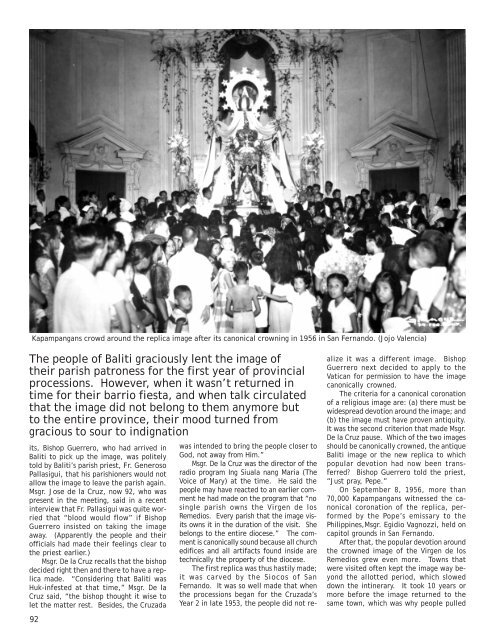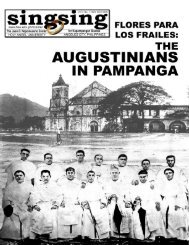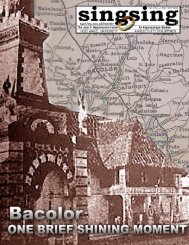Download PDF - Holy Angel University
Download PDF - Holy Angel University
Download PDF - Holy Angel University
You also want an ePaper? Increase the reach of your titles
YUMPU automatically turns print PDFs into web optimized ePapers that Google loves.
Kapampangans crowd around the replica image after its canonical crowning in 1956 in San Fernando. (Jojo Valencia)<br />
The people of Baliti graciously lent the image of<br />
their parish patroness for the first year of provincial<br />
processions. However, when it wasn’t returned in<br />
time for their barrio fiesta, and when talk circulated<br />
that the image did not belong to them anymore but<br />
to the entire province, their mood turned from<br />
gracious to sour to indignation<br />
its, Bishop Guerrero, who had arrived in<br />
Baliti to pick up the image, was politely<br />
told by Baliti’s parish priest, Fr. Generoso<br />
Pallasigui, that his parishioners would not<br />
allow the image to leave the parish again.<br />
Msgr. Jose de la Cruz, now 92, who was<br />
present in the meeting, said in a recent<br />
interview that Fr. Pallasigui was quite worried<br />
that “blood would flow” if Bishop<br />
Guerrero insisted on taking the image<br />
away. (Apparently the people and their<br />
officials had made their feelings clear to<br />
the priest earlier.)<br />
Msgr. De la Cruz recalls that the bishop<br />
decided right then and there to have a replica<br />
made. “Considering that Baliti was<br />
Huk-infested at that time,” Msgr. De la<br />
Cruz said, “the bishop thought it wise to<br />
let the matter rest. Besides, the Cruzada<br />
92<br />
was intended to bring the people closer to<br />
God, not away from Him.”<br />
Msgr. De la Cruz was the director of the<br />
radio program Ing Siuala nang Maria (The<br />
Voice of Mary) at the time. He said the<br />
people may have reacted to an earlier comment<br />
he had made on the program that “no<br />
single parish owns the Virgen de los<br />
Remedios. Every parish that the image visits<br />
owns it in the duration of the visit. She<br />
belongs to the entire diocese.” The comment<br />
is canonically sound because all church<br />
edifices and all artifacts found inside are<br />
technically the property of the diocese.<br />
The first replica was thus hastily made;<br />
it was carved by the Siocos of San<br />
Fernando. It was so well made that when<br />
the processions began for the Cruzada’s<br />
Year 2 in late 1953, the people did not re-<br />
alize it was a different image. Bishop<br />
Guerrero next decided to apply to the<br />
Vatican for permission to have the image<br />
canonically crowned.<br />
The criteria for a canonical coronation<br />
of a religious image are: (a) there must be<br />
widespread devotion around the image; and<br />
(b) the image must have proven antiquity.<br />
It was the second criterion that made Msgr.<br />
De la Cruz pause. Which of the two images<br />
should be canonically crowned, the antique<br />
Baliti image or the new replica to which<br />
popular devotion had now been transferred?<br />
Bishop Guerrero told the priest,<br />
“Just pray, Pepe.”<br />
On September 8, 1956, more than<br />
70,000 Kapampangans witnessed the canonical<br />
coronation of the replica, performed<br />
by the Pope’s emissary to the<br />
Philippines,Msgr. Egidio Vagnozzi, held on<br />
capitol grounds in San Fernando.<br />
After that, the popular devotion around<br />
the crowned image of the Virgen de los<br />
Remedios grew even more. Towns that<br />
were visited often kept the image way beyond<br />
the allotted period, which slowed<br />
down the intinerary. It took 10 years or<br />
more before the image returned to the<br />
same town, which was why people pulled








